Are you ready to take your blogging game to the next level? Look no further than ChatGPT (Generative Pre-trained Transformer)! This incredible language model has been the talk of the town lately, and you’re about to discover how it can revolutionize your blogging experience. In this article, I’ll share some fantastic ideas on how to use ChatGPT for blogging, along with a few other handy tools that can amplify your writing prowess.
What Is ChatGPT?
Let’s begin by acquainting ourselves with ChatGPT. It’s an exceptional chatbot designed to engage in conversational exchanges.
The best part? It’s free! That’s right, ChatGPT is your go-to tool for brainstorming and refining your blogging ideas. Launched in November 2022 by OpenAI and trained on top of GPT-3.5, ChatGPT’s knowledge base encompasses events up until 2021.
Now, let’s clarify a few key facts. Sam Altman, the CEO of OpenAI, played a pivotal role in developing ChatGPT. However, it’s important to note that Elon Musk isn’t the owner of ChatGPT, although he did contribute to OpenAI at some point. Furthermore, ChatGPT wasn’t created by Joseph Weizenbaum, who was a renowned professor at MIT and a prominent figure in the realm of artificial intelligence.
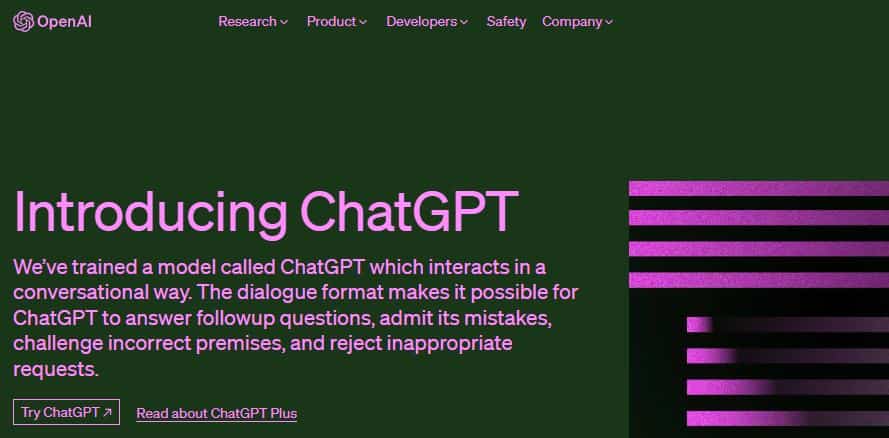
Real-Time Conversations With WebChatGPT
WebChatGPT, an open-source extension takes ChatGPT to the next level. This incredible tool adds current and relevant web results to ChatGPT’s responses, ensuring your conversations stay accurate and up-to-date.
How To Use ChatGPT For Blogging
Now, let’s look at 15 different ways by which you can harness ChatGPT’s potential to enhance your blogging game:
1. Supercharge Your Keyword Research
Keywords are the lifeblood of effective blogging. They play a pivotal role in boosting your organic search engine traffic.
With ChatGPT by your side, you can develop compelling long-tail keywords that will enhance your blog posts. Take a look at the comprehensive list of cool and creative uses of ChatGPT for more inspiration.
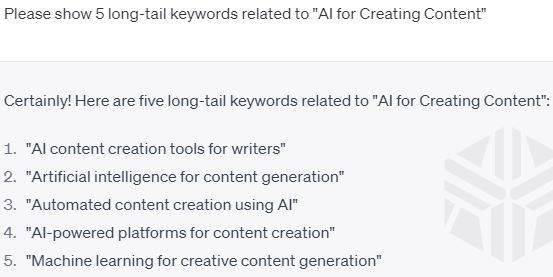
It’s essential to validate your chosen keywords using a reliable SEO tool like Semrush or Ahrefs.
Please note that ChatGPT’s training data doesn’t include keyword metrics. For a deeper understanding of keywords, backlinks, and ranking, check out the in-depth Ahrefs review. Additionally, explore Semrush’s Keyword Magic tool.
2. Content Planning Expertise
Crafting a solid content strategy is the foundation of successful blogging. It’s all about aligning your business goals, identifying your target audience, and creating a detailed content plan.
With ChatGPT, you can consistently deliver valuable content that establishes you as an industry expert. This, in turn, boosts brand loyalty and solidifies your authority status.
To get started, follow these steps to address content gaps:
- Begin by listing the keywords already covered in your articles.
- Categorize these keywords into clusters based on their relevance.
- Identify weak clusters with insufficient articles and seek ChatGPT’s assistance in suggesting additional keywords to enrich those clusters.
- Use ChatGPT to write informative articles that fill those content gaps (learn how to make money with ChatGPT).
Remember, it’s crucial to run your keywords through an SEO tool and fact-check all generated text to ensure accuracy and optimization.
3. Search Intent With Ease
If you find yourself puzzled by the search intent behind certain keywords, ChatGPT could help.
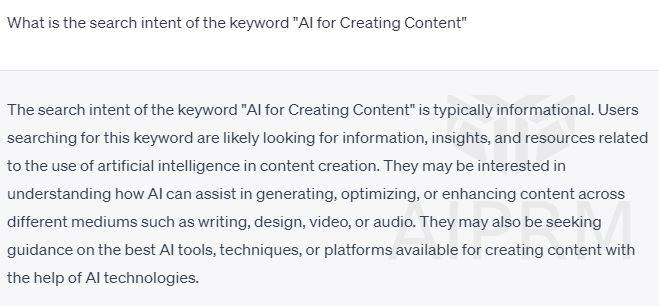
You can gain clarity on the intent behind those keywords and align your content accordingly. This way you don’t have to do any guesswork and can target content that resonates with your audience.
4. Master The Art Of Keyword Clustering
ChatGPT not only generates keywords but also retains the conversation history, allowing you to delve deeper into its capabilities. You can ask ChatGPT to cluster your keywords, organizing them for greater efficiency and effectiveness.
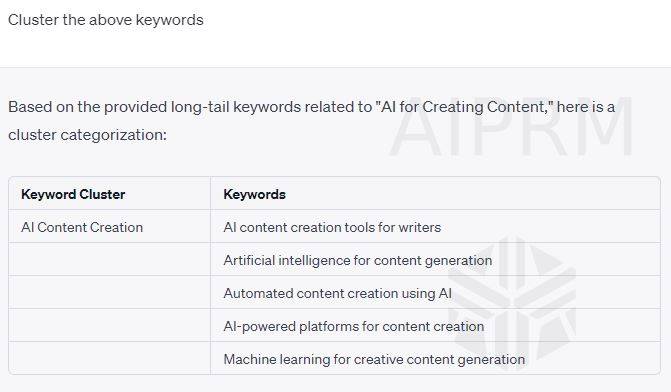
5. Generating Ideas
Besides content ideas, ChatGPT can assist in generating ideas for persuasive sales copy, high-quality product reviews, video content, and engaging infographics to increase engagement and drive traffic to your blog.
ChatGPT For Content Creation – How To Use Chat GPT To Write Website Content
With ChatGPT by your side, the process of crafting engaging content becomes a breeze. By providing the right input, you can enlist ChatGPT’s assistance in creating an entire article from start to finish.
Here’s a suggested approach to collaborate with ChatGPT at various stages of your blog post creation:
- Outline: Let ChatGPT generate brilliant ideas for your blog post outline, saving you time and kickstarting your writing process.
- Blog Title: Seek ChatGPT’s creative suggestions to come up with a catchy title that incorporates your target keyword.
- Sub-headings: Collaborate with ChatGPT to craft compelling sub-headings that captivate your readers and optimize them for SEO purposes.
- Introduction: Ask ChatGPT to compose an engaging introduction, ensuring the keyword is seamlessly incorporated within the first or second sentence.
- Content: With your outline in hand, instruct ChatGPT to expand on each section, specifying the desired keyword inclusion and desired length for each segment.
- Conclusion: Once the body of your post is complete, rely on ChatGPT to write a powerful conclusion that leaves a lasting impact on your readers.
Explore the list of innovative ways for how to use ChatGPT for SEO purposes.
6. Developing An Effective Blog Post Outline
Need assistance in outlining your blog post? ChatGPT is here to inspire you! Ask this AI tool to generate ideas for an outline that aligns with your chosen topic.

Don’t forget to optimize the outline for SEO purposes, which we will be covering in detail later. And if you’re seeking further guidance, be sure to check out the article on how to create a compelling blog post outline.
7. Creating Titles: How To Use Chat GPT To Write Blog Posts
To grab your readers’ attention, a captivating title is crucial, and ChatGPT can help you create one that incorporates your chosen keyword. Let’s take a look at the results when I instructed ChatGPT to use the keyword “AI for Creating Content”:
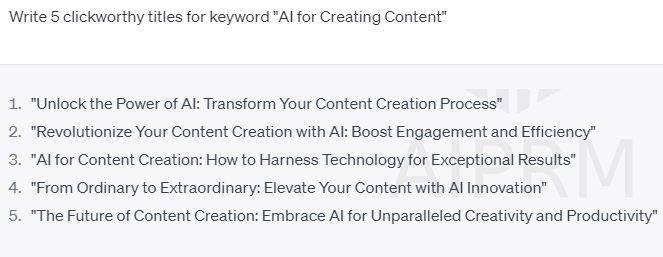
As you can see, ChatGPT does an impressive job, even if not every title includes the exact keyword. It’s all about finding that perfect balance!
8. Crafting Engaging Meta Descriptions
Now you can turn to ChatGPT for intriguing ideas to create attention-grabbing meta descriptions for the aforementioned blog. These meta-descriptions play a crucial role in attracting more traffic from search engines.
If the initial suggestions exceed the optimal length of 160 characters, you can request ChatGPT to read them and rewrite them within the specified limit. Alternatively, you can instruct ChatGPT from the start to generate meta descriptions that stay under 160 characters.
By leveraging ChatGPT’s capabilities, you can optimize your meta descriptions for search engine visibility and entice readers to click through to your blog.
9. Write A Captivating Introduction
The introduction sets the stage for your entire blog post. Instruct ChatGPT to compose an attention-grabbing introduction based on your blog title, ensuring the keyword is seamlessly woven into the first or second sentence.

With ChatGPT’s assistance, you’ll hook your readers right from the beginning.
10. Expanding On Engaging Content
With your outline in hand, it’s time to get into the body of your blog post. ChatGPT can help you expand on each section, adding depth and value to your content.
Simply provide ChatGPT with instructions on which keywords to include and specify the desired length for each segment. Together, you and ChatGPT can create an extraordinary piece that captivates your audience.
You might also be interested in checking out how to use ChatGPT for essays.
11. Crafting An Impactful Conclusion
As you near the end of your blog post, rely on ChatGPT to craft a powerful conclusion. This section will leave a lasting impression on your readers, so instruct ChatGPT to summarize key points, offer insights, or provide a call to action.
With ChatGPT’s assistance, your conclusion will resonate with your audience and inspire them to take the desired next steps.
12. Copywriting Frameworks
Copywriting frameworks are invaluable tools employed by copywriters to structure and convey information in a manner that effectively communicates the intended message to the target audience.
These frameworks offer a systematic approach, guiding the copywriter through each step of organizing and presenting information, from capturing attention to arousing interest, creating desire, and prompting action.
Numerous copywriting frameworks exist, including AIDA, USP, PAS, Monomyth, Soap Opera Sequence, and many more. The choice of framework depends on the message and the specific audience being targeted.
Implementing a copywriting framework not only makes the message more relatable but also keeps the audience engaged, thereby enhancing the effectiveness and persuasiveness of the communication.
13. Use Striking Images
Visuals play a vital role in capturing your readers’ attention, and ChatGPT can assist you in generating image ideas for your blog post. For example, you can ask ChatGPT to provide three image ideas for each heading in your blog post. However, for illustrative purposes, let’s focus on generating ideas for the topic.
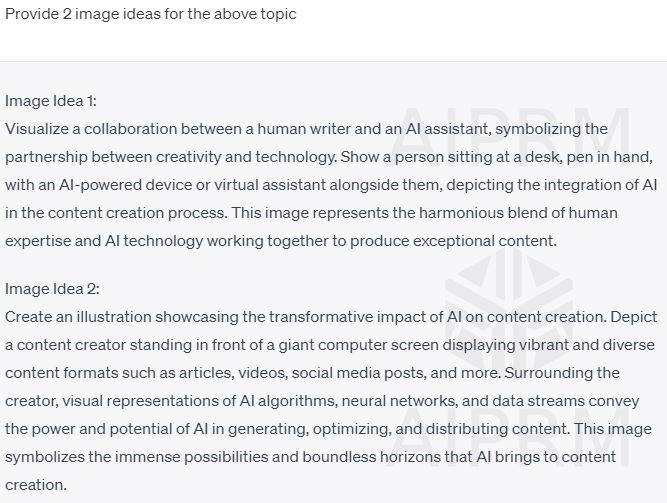
Additionally, if you’re eager to explore another powerful tool, I recommend trying out DALL-E 2 for image generation. This cutting-edge AI system can bring your textual descriptions to life, producing realistic and captivating images. With DALL-E 2, you have the opportunity to move beyond stock images and create visuals that are truly unique and tailored to your blog’s style.
By providing a simple text description like “a photo of a cute dog” or “a middle-aged man with six-pack abs,” DALL-E 2 can generate stunning images that match your vision. It’s a game-changer, allowing you to convey your message more powerfully and engage your audience on a whole new level.
In summary, DALL-E 2 revolutionizes image creation for your blog, enabling you to showcase unique and captivating visuals that amplify your content’s impact.
14. Writing A Newsletter
With its language generation capabilities, ChatGPT can help you compose a concise and engaging newsletter that delivers your message effectively to your subscribers.
Whether you’re announcing updates, sharing valuable insights, or promoting your blog content, ChatGPT is ready to assist you in crafting a compelling newsletter.
You may also be interested in checking out the Newsletter Title Generator.
Promoting Your Blog For Success
Promoting your blog is vital for building an audience and driving traffic to your website. Here are some effective strategies to consider:
- Social Media Promotion: Leverage social media platforms such as Instagram, Twitter, and Facebook to share your blog posts. Engage with your followers, encourage discussions, and provide valuable insights.
- Guest Blogging: Seek opportunities to contribute guest posts on other websites within your niche. This enables you to reach a new audience, establish yourself as an authority, and drive traffic back to your own blog.
- SEO Tactics: Implement SEO techniques like keyword research and optimization of meta tags. This will improve your blog’s visibility in search engines, making it more discoverable to potential readers.
15. Promotional Material For Social Media
With ChatGPT, you can effortlessly create promotional material tailored for various social media platforms, including Twitter and Facebook.
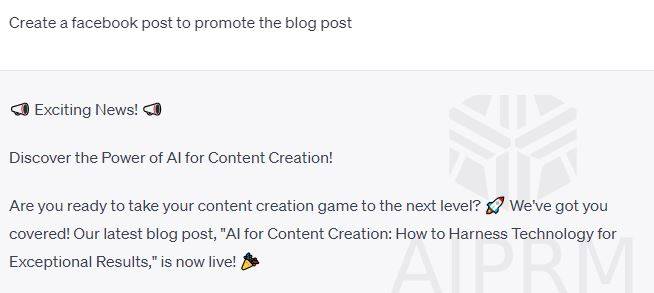
Whether you need engaging captions, compelling posts, or creative visual content, ChatGPT is equipped to assist you in capturing the attention of your target audience and driving engagement on social media.
16. Creating A WordPress Schema
Imagine you have a question in the FAQ section of your website.
You can rely on the AI assistant to generate the FAQ Schema for that particular question. ChatGPT can provide you with a structured format that meets the requirements of the FAQ Schema.
You can check the example generated by ChatGPT to see if it passes the Rich Results Test, to ensure that your content is presented effectively in search engine results.
17. Domain Names
Catchy domain names are crucial for attracting attention and standing out. ChatGPT can help you generate a list of domain name ideas. For example, you can ask for 5 domain names for a website dedicated to ” AI for Creating Content.”
Remember to check the availability of the generated domain names.
18. Converting YouTube Videos To Blog Posts
Converting YouTube videos into blog posts can be done using ChatGPT or dedicated applications like Jasper. Here’s a manual process using ChatGPT:
- Go to the desired YouTube video and enable captions by clicking on “CC.”
- Click on the three dots and select “Show transcript.”
- Disable time stamps by clicking on the three vertical dots.
- Select all the transcript text, copy it, and paste it into your preferred text editor.
- Divide the content into logical paragraphs for readability.
- Ask ChatGPT to rewrite each paragraph, requesting multiple versions if needed. Additionally, you can ask for suggested headlines.
- Format the content, add headings, and do any necessary editing to finalize your blog post.
There is an extension called “YouTube & Article Summary powered by ChatGPT” that can summarize a video, which may be useful during this process.
19. Rewriting Old Content: Improving Blog Writing With ChatGPT
ChatGPT can assist in improving old content using the following strategies:
- Rewrite paragraphs or specific phrases, incorporating new ideas and perspectives.
- Change the tone of the content to align with current goals or branding.
- Update the information to ensure accuracy and relevance. Verify all data and statistics included in the post.
- Add new information or research findings related to the topic, enhancing the value of the post for readers.
- Update meta descriptions if necessary to improve the post’s visibility in search results.
- Promote the updated post through social media channels, reaching both new and existing followers.
- Utilize the post for email marketing campaigns, providing value to subscribers and driving traffic to the blog.
- Expand the post by creating additional content around it, such as related blog posts, videos, podcasts, etc., treating it as pillar content.
By implementing these strategies, bloggers can revitalize their old content, make it more valuable, and reach a wider audience.
20. Sentiment Analysis
Sentiment analysis is a valuable tool for bloggers as it allows them to understand how their audience perceives and reacts to their content.
By analyzing the sentiment of comments and social media posts, bloggers can gain insights into their readers’ preferences, likes, and dislikes. This information can be used to create more engaging and relevant content that resonates with the audience.
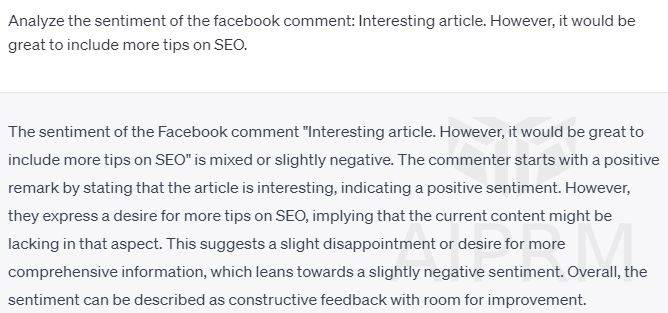
Moreover, sentiment analysis helps bloggers identify potential problems or concerns that their readers might have. By promptly addressing these concerns, bloggers can build trust and improve their relationships with their audience.
Overall, sentiment analysis is a powerful tool that enables bloggers to enhance engagement, understand their readers’ needs and preferences, and continuously improve their content strategy.
ChatGPT And SEO For Content Writing: Optimizing Blogging With ChatGPT
When it comes to content writing and SEO, ChatGPT can be a valuable tool. However, it’s important to consider certain aspects in order to optimize your article for search engine rankings. Here are the steps you can follow:
Analyze Competitors
Identify competitors with low Domain Authority (DA) or Domain Rating (DR) on the first page of Google.
While ChatGPT doesn’t consider the SERP, you can use tools like Surfer SEO and PageOptimizer Pro to gather information about your competitors’ article structures.
Surfer SEO provides insights on headings (H2s and H3s), keyword density, LSI and NLP words, and keyword usage in headings.
PageOptimizer Pro complements Surfer SEO and covers other essential points. You can find helpful YouTube videos on SEO tutorials, on-page optimization, SEO content writing, and ranking higher on Google.
Outline Generation
Once you have the necessary information from the competitor analysis, you can utilize the power of ChatGPT to create an outline.
Ask ChatGPT for headings and specify the exact keywords you want to include.
You can also request an introduction and paragraphs with specific content requirements. This collaborative approach ensures that you incorporate relevant information and keywords.
Perfecting The Article
Following these steps might be time-consuming and challenging, but they can help you create a well-optimized article.
Remember to review and add your personal touch to the content generated by ChatGPT. While ChatGPT is a powerful tool, human input is essential to ensure the final content aligns with your goals and preferences.
Bonus Tools And Resources
In addition to using ChatGPT to write content, you can explore other resources and tools to enhance your SEO efforts:
- Thruuu: This tool, available in both free and paid versions, helps you scrape the top 10 to top 100 articles on the SERP. Thruuu provides information on word count, H1, H2s, H3s, number of images, and more for each article it scrapes.
- ChatGPT SEO Extension (AIPRM for SEO): This extension allows you to create a keyword strategy and generate SEO-optimized content to outrank your competition.
- SEO Pro Extension: Another useful Chrome extension for SEO purposes.
- SEOquake: This Semrush Chrome extension provides various SEO metrics and data, helping you analyze and optimize your content.
AI Detection Software

AI detection software utilizes artificial intelligence algorithms to identify and classify text generated by machines or computers.
This software is useful for various purposes, such as identifying plagiarism, detecting fake news, or filtering out automated spam messages. It operates on machine learning (ML) techniques, enabling it to improve its performance over time by learning from examples of AI-generated text.
The goal of AI-generated text detection is to accurately distinguish between machine-generated text and human-generated text.
Some applications for AI text detection include:
However, it’s important to note that these tools still need to be proven and refined. The detection of AI-generated text is an ongoing challenge, and the methods used to identify such text can quickly become outdated. It’s essentially an ongoing arms race, and currently, there is still much progress to be made in this area.
During tests, tools designed to detect GPT-2 were found to be reliable in detecting code generated by ChatGPT. However, it’s worth remembering that ChatGPT, unlike OpenAI, doesn’t offer parameter adjustments such as temperature and frequency.
Originality.ai occasionally yielded false positives and could be confused by slight modifications to AI-generated content. Adding just a few characters to a 100-word paragraph sometimes resulted in the AI-generated content being reassessed as original content.
FAQs – How To Use Chat GPT For Blogging
1. Can you use ChatGPT to write articles?
Yes, ChatGPT can be used to write articles. It is a versatile language model that can generate text on various topics.
2. How to use Chat GPT to write articles?
To use ChatGPT for writing articles, you can provide it with a specific topic or outline, and then interact with the model through a series of prompts to generate the desired content. You can refine and iterate on the generated text until you’re satisfied with the result.
3. What are some fun uses of ChatGPT?
Some fun uses of ChatGPT include creating fictional stories, generating jokes, engaging in role-playing dialogues, or even having philosophical conversations. It can be an entertaining and creative tool for exploring different ideas and perspectives.
4. Is there a ChatGPT blog post prompt?
OpenAI has not provided a specific blog post prompt for ChatGPT. However, you can provide a general topic or specific guidelines to the model to generate content that can be used as a blog post.
5. What’s the difference between Chat GPT vs blogging?
ChatGPT and blogging serve different purposes. ChatGPT is an AI language model designed for interactive and dynamic conversations. It excels at generating responses and engaging in back-and-forth dialogue.
On the other hand, blogging involves writing articles or posts on specific topics in a more structured and comprehensive manner. While ChatGPT can assist in generating content for blogs, the process and style of interaction differ from traditional blogging approaches.
Conclusion: How To Use ChatGPT For Blogging
It’s worth considering Google’s position on AI-generated content as a blogger. Google does not currently seem to reduce organic traffic to a piece based on the extent of AI assistance used in its creation. However, Google’s stance on AI-generated content may evolve in the future.
While ChatGPT is a powerful tool, it’s important to remember the human touch. Always review and refine the content generated by the model to add your personal touch and ensure it aligns with your brand and style.
ChatGPT offers bloggers and content creators numerous ways to leverage AI for inspiration and productivity. From generating ideas and outlines to writing complete blog posts, ChatGPT is a versatile tool that can save time and enhance the blogging process.
The tactics discussed earlier, along with the bonus tips, provide valuable strategies for maximizing ChatGPT’s capabilities to improve SEO, increase traffic, and produce better blog posts.
Embrace, experiment, and confidently step into the future with this AI-powered chatbot as your ally.




